
A Guide to Commercial Drawer Warmers
Commercial drawer warmers are essential equipment for foodservice establishments looking to maintain the quality and temperature of their prepared dishes. These versatile units are commonly used in restaurants, catering businesses, cafeterias, and other commercial kitchens to keep food items warm and ready for serving. Understanding the different types of drawer warmers and how to properly operate and care for your unit allows your restaurant to serve warm and fresh meals to customers, enhancing their overall experience.
Shop All Warming Drawers
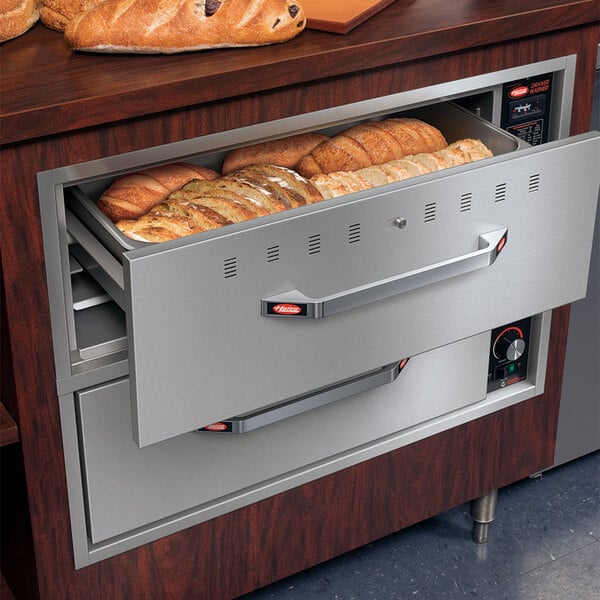
A drawer warmer typically consists of a stainless steel cabinet with one or more drawers that are designed to hold food pans. The drawers are equipped with heating elements that evenly distribute heat throughout the cabinet, ensuring that food stays warm without drying out or becoming overcooked. Most drawer warmers have adjustable temperature controls, allowing operators to set the desired temperature based on the type of food being held.
Drawer warmers are also available in various sizes and configurations to accommodate different kitchen layouts and volume needs. Some models feature multiple drawers, while others have a single large drawer for holding larger quantities of food. Additionally, some drawer warmers come with options such as moisture controls or humidity settings to help preserve the texture and quality of delicate foods like baked goods or fried items.
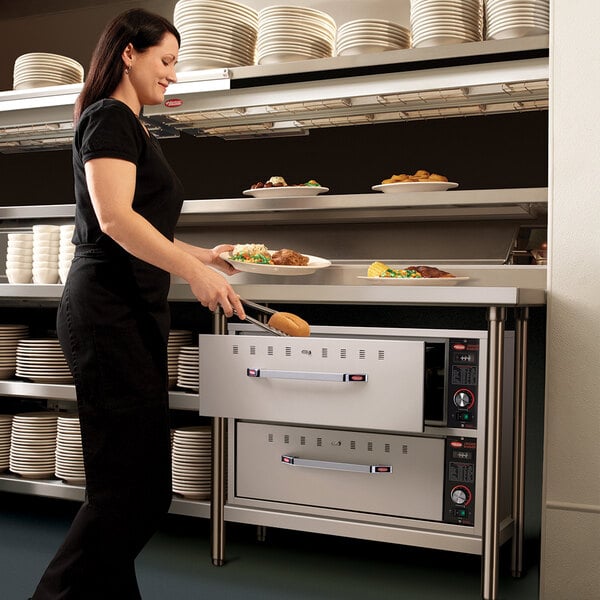
Whether you run a commercial kitchen or are catering a large event, drawer warmers can keep your foods fresh and ready to serve. That being said, there are certain tasks drawer warmers excel at, and certain uses that should be avoided for safety purposes.
- Order Holding - These units can be utilized by servers and front-of-the-house staff to hold frequently ordered appetizers and sides such as nachos, tortillas, bread loaves, and bread rolls
- Ingredient Holding - Prep and line cooks use warming drawers to keep hot components of daily specials ready to churn out, cutting down on cooking times and turnover rates
- Heating Dinnerware - Drawer warmers can be used to warm plates, bowls, cups, and other oven-safe dinnerware
- Proofing - Occasionally used at low temperatures to proof bread dough
- Cooking or Heating Up Food - Drawer warmers should not be used to cook or heat up any type of food, especially potentially hazardous foods
- Plastic Wrap - Do not place any items with plastic wrap or any conventional plastic containers in a drawer warmer as they can easily melt
- Non-Oven-Safe Dinnerware - Ensure that all dinnerware heated in drawer warmers are oven-safe to ensure safe use
Drawer warmers offer a range of benefits that contribute to efficient food service operations. Understanding the advantages of these appliances can help businesses make informed decisions when outfitting their kitchen spaces and can improve the efficiency of a kitchen's operation.
- Keeps Food Fresh - Drawer warmers help keep food fresh and at the optimal serving temperature. This is crucial for maintaining the quality and integrity of dishes, ensuring that customers receive delicious and satisfying meals every time.
- Energy Efficient - These units are designed to provide consistent heat to keep food items warm without the need for constant monitoring or reheating. By maintaining the desired temperature within the drawers, businesses can save on energy costs and reduce waste associated with food spoilage.
- Meal Prep - Drawer warmers also play a vital role in meal preparation workflows in commercial kitchens. With designated compartments for hot food storage, chefs and foodservice professionals can organize and store different menu items before plating and serving. This allows for better time management and smoother operations during peak service hours, enhancing overall kitchen efficiency.
- Organization - Drawer warmers provide a designated space for hot food items, keeping them separate from cold or room-temperature ingredients. This segregation helps prevent cross-contamination and allows for better organization within your commercial kitchen.
Should I Invest in a Drawer Warmer?
An important factor to consider when thinking about investing in a drawer warmer for your business is quantity. If the output of specific menu items or staple ingredients is high, and being able to cook ahead of time will help you easily meet demand and even sell more in the process, a drawer warmer will be a welcomed addition.
If catering is your specialty or you find yourself frequently preparing for large groups, a warmer will help you maintain that just-cooked look and taste to achieve a satisfying standard of quality while meeting quantity requirements. A warmer can serve as one of the workhorses of your kitchen and ease any concerns you might have when those large groups arrive. If the demand is there, this versatile piece of equipment may be well worth the investment.
Drawer warmers come in various types, each designed to cater to specific commercial needs. Depending on your kitchen's needs and requirements, different drawer warmers will be best suited for the job.


Narrow drawers are a specific type of drawer warmer unit designed for commercial kitchen applications where space is limited. These drawers are typically smaller in width compared to standard drawer warmers, making them ideal for establishments with restricted countertop or undercounter space.
- Takes up a limited amount of space
- Limited width of narrow drawers can help with portion control
- Limited capacity compared to wider models
- May not accommodate certain types of food pans or containers


Standard drawers provide a great compromise between capacity and space efficiency. Their relatively compact size makes them suitable for most kitchens, while still being able to hold more food than narrow drawers.
- Suitable for a wide range of commercial kitchens
- Can accommodate several different food pan types
- Require more space than narrow models
- Less capacity than larger models
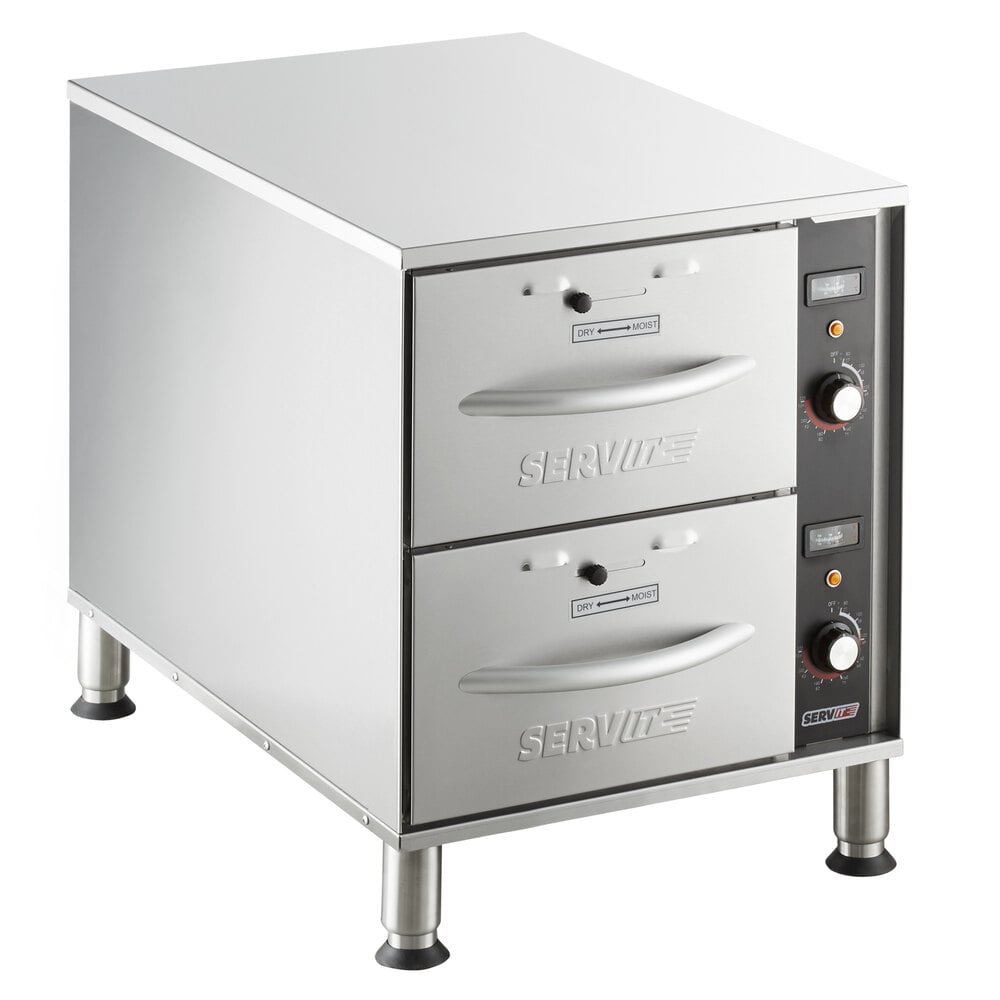

Freestanding drawer warmers are standalone units that can be placed anywhere in the kitchen for easy access to warm dishes. These units are perfect for catering events, buffet setups, or front-of-house applications where food needs to be kept warm and easily accessible to customers.
- Easily moved, allowing flexibility in placement
- Ideal for catering businesses or temporary foodservice setups
- Takes up valuable floor space
- May not seamlessly blend with the existing kitchen decor or equipment


These units are designed to be integrated seamlessly into existing kitchen equipment, such as under counters or cooktops. Built-in warmers provide a streamlined look and save valuable counter space, making them a popular choice for commercial kitchens looking to optimize their layout.
- Provides a seamless and streamlined kitchen look
- Saves counter space
- Requires designated installation space
- May require additional costs for installation
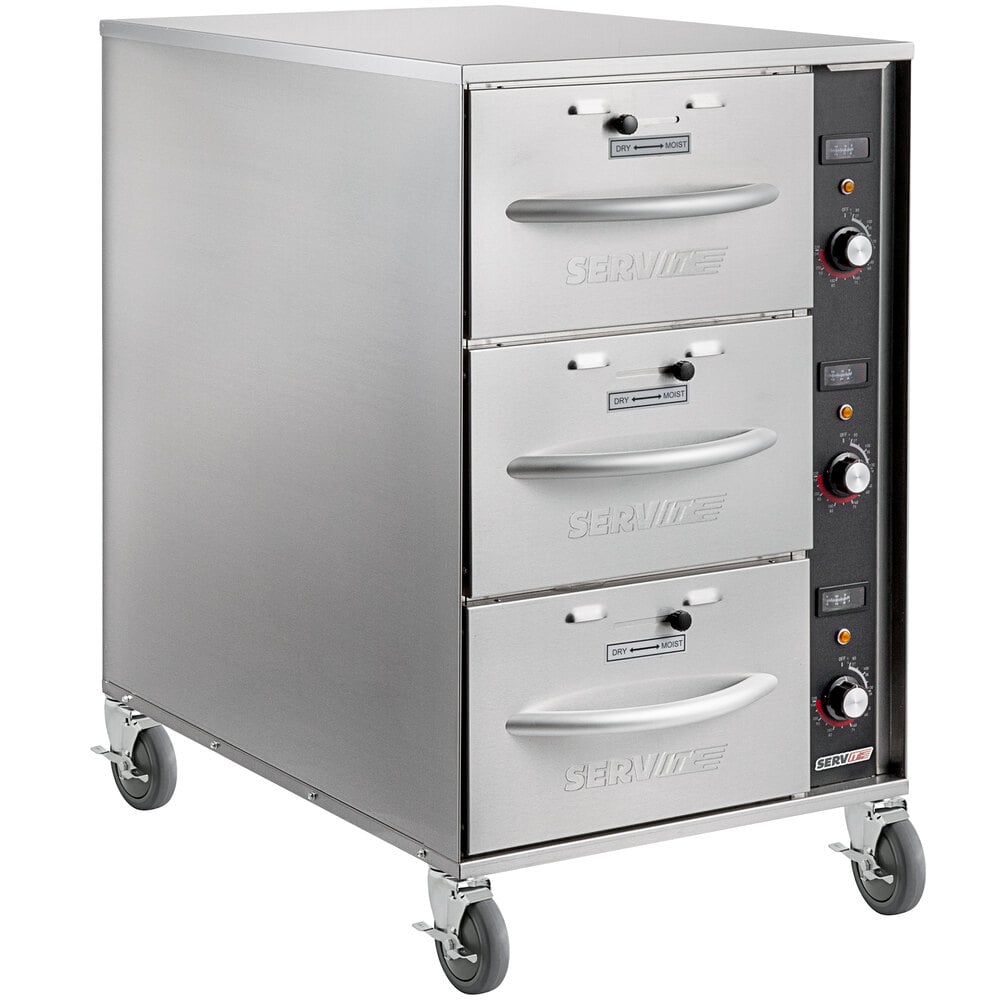

Mobile drawer warmers are equipped with casters or wheels, allowing for easy mobility around the kitchen or catering venue. These units are ideal for catering businesses, banquet halls, or event venues where food needs to be transported and kept warm throughout the service.
- Mobility is great for on-the-go food warming solutions
- Can be stored away when not in use
- May be more expensive
- Limited holding capacity
Having the right controls in a commercial drawer warmer is crucial for maintaining food quality, ensuring food safety, and meeting regulatory requirements. Whether using thermostatic controls for simple temperature adjustments or digital controls for precise temperature management, operators can rely on these controls to keep their food items at the perfect serving temperature until they are ready to be served.

Thermostatic Controls
These controls allow operators to set and adjust the temperature inside the warmer to meet specific food holding requirements. By turning a dial or adjusting a knob on a thermostatic unit, users can fine-tune the temperature settings to keep different types of food items at their optimal serving temperatures.
- User-friendly controls
- Provides a simple and effective way to regulate drawer heat levels
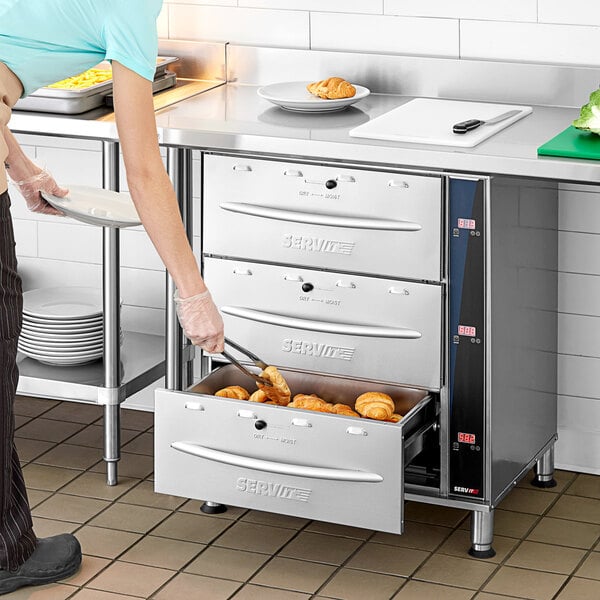
Digital Controls
Digital controls offer precise temperature management with digital displays that show the exact temperature inside the unit. Operators can easily set the desired temperature using buttons or touchscreens, providing accurate control over the warming process.
- Offers precise temperature control for operators
- Often comes with additional features such as programmable settings, timers, and temperature alarms
With proper training, using a warming drawer is simple for your most experienced cook and your newest server alike. Though control options may vary across models, the same basic functions apply to all units. After you've selected the right warmer for your business needs, ensure that it is securely resting or installed in an ideal location away from water sources. Use the following tips and instructions for optimal results.
- Voltage - Before using the drawer warmer, ensure that it is properly connected to a power source that matches its voltage requirements. Most drawer warmers operate on standard voltages such as 120V or 240V, so make sure to check the specifications of your unit and have it connected by a qualified electrician if needed.
- Temperature - Adjust the temperature setting on the drawer warmer to the desired level based on the type of food you are storing. Most drawer warmers feature easy-to-use temperature controls that allow you to set the unit to the precise temperature needed to keep your food warm and ready for serving.
- Airflow Control - Some drawer warmers come equipped with airflow control features that allow you to regulate the amount of airflow within the unit. This feature is particularly useful for maintaining the quality of delicate foods that require gentle warming without drying out. Adjust the airflow control settings according to the specific requirements of the food you are storing in the drawer warmer.
- Moisture - Excessive moisture can affect the texture and quality of the food items being stored. To prevent moisture buildup, ensure that the food items are properly covered or wrapped before placing them in the warmer. Additionally, regularly check and clean the interior of the drawer warmer to prevent any excess moisture accumulation.
How to Use a Drawer Warmer for Proofing Dough
Though less conventional, it is possible for a warming drawer to be used as a proofing drawer. This is discouraged by some, as cold proofing via refrigeration is said to allow for a longer, more stable rise, resulting in improved taste and structure. Some warmer units have a proof mode that will fall between 80 degrees Fahrenheit (or lower) up to 110 degrees Fahrenheit, though at normal ambient room temperature of around 75 degrees Fahrenheit, it is recommended to proof dough between 80 and 90 degrees Fahrenheit.
Typical proofing cabinets have relative humidity levels of around 80%, meaning you should aim to restrict airflow to the drawer, keeping the vents closed and placing a separate pan of water into the drawer alongside the dough for optimal humidity. Proof dough in a separate container, and do not rest it directly on the bottom of the drawer. Allow dough to rest in the drawer for around 40 minutes, or until it has doubled in size and an impression remains in the surface after pressing it with a finger.
How to Use a Drawer Warmer for Warming Dinnerware
Keeping dinnerware warm before plating and serving is another less conventional use for drawer warmers. Some operators prefer to do this based on the notion that some hot dishes maintain better flavor and consistency and stay warm longer when using preheated plates, bowls, or other dinnerware.
- Place Dinnerware Items - Arrange the dinnerware items inside the drawer warmer, ensuring that they are evenly spaced to allow for proper heat distribution.
- Set Temperature - Adjust the temperature settings on the drawer warmer according to the manufacturer's instructions and check periodically to ensure that the items are reaching the desired temperature without overheating.
- Remove Items - Once the dinnerware has reached the desired temperature, carefully remove it from the drawer warmer using heat-resistant gloves or tongs.
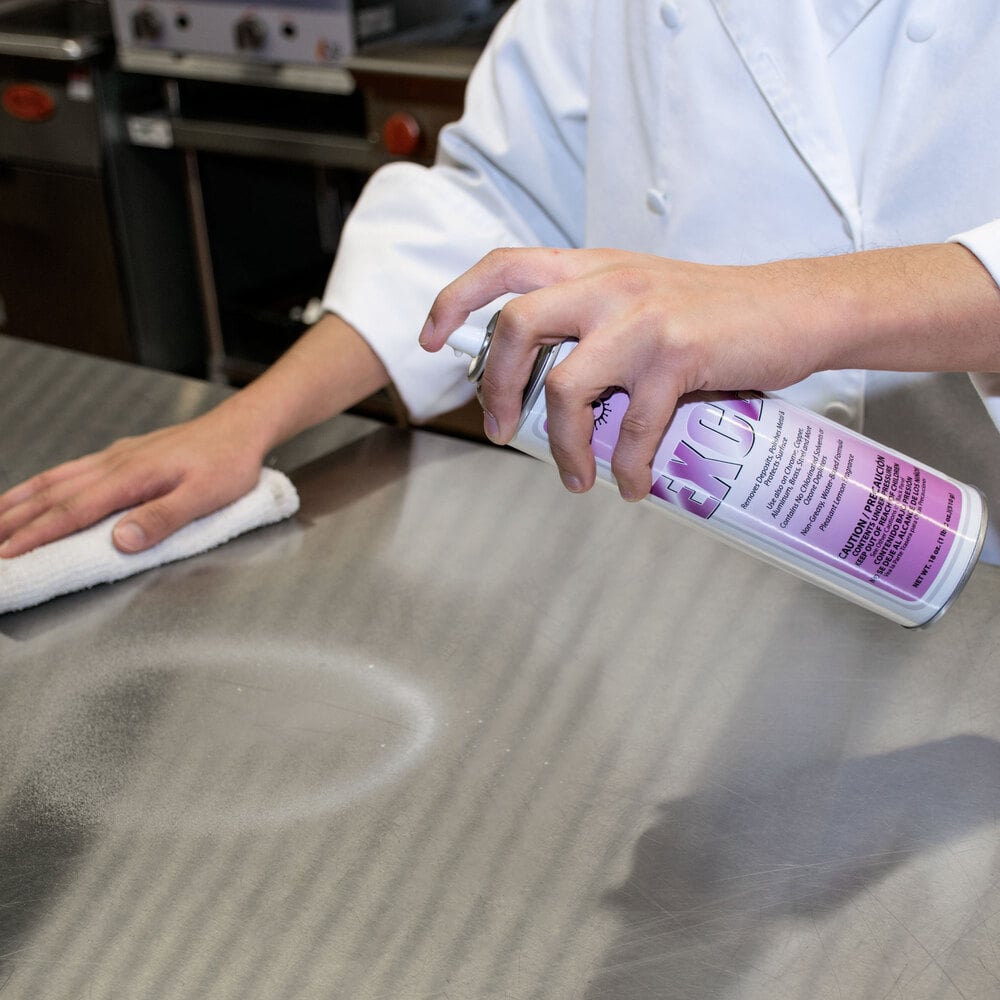
To ensure the longevity and efficiency of your drawer warmer, daily cleaning and maintenance are crucial. Here are some tips to properly clean your commercial drawer warmer:
- Power Down Unit and Unplug - Make sure to shut off and unplug the drawer warmer from the power source before cleaning to prevent any accidents.
- Remove Pans and Drawers - Prior to cleaning, remove all pans, liners, and drawers out of the unit. Rinse thoroughly and allow them to dry completely before placing them back in the warmer.
- Clean the Interior - Wipe down the interior surfaces of the drawer warmer with a damp cloth and a mild detergent solution. Pay special attention to any spills or food residue that may have accumulated.
- External Cleaning - Wipe down the exterior of the drawer warmer with a damp cloth to remove any grease, dirt, or fingerprints. Use a stainless steel cleaner for stainless steel units to maintain a polished appearance.

A 3:1 ratio of water (75%) and white vinegar (25%) may be used to remove lime scale and other mineral deposits. Fill the existing water pan or a separate stainless steel pan with the mixture and place it into the drawer of the unit. Power the unit on and allow it to run for 30 minutes, then turn the unit off and let the pan sit in the unit for 2 or more hours depending on the severity of the buildup.
Related Resources
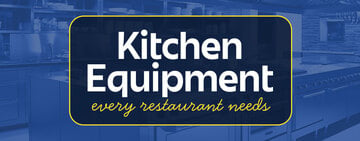
Kitchen Equipment Every Restaurant Needs
Selecting the appropriate restaurant kitchen equipment is crucial for success when opening a new restaurant or renovating your existing business. Depending on your type of restaurant, you might need to invest in fine china or extra deep fryers. We compiled a comprehensive list of essential restaurant equipment to provide a starting point for equipping your kitchen. Though this list serves as a foundation that encompasses the staples nearly every restaurant needs, you can expand it to meet your unique requirements. Download Equipment List PDF Click below to learn more about commercial kitchen equipment: Cooking Equipment Beverage Equipment Refrigeration Equipment Storage Equipment Food Prep Equipment Smallwares Janitorial Equipment 1. Cookin
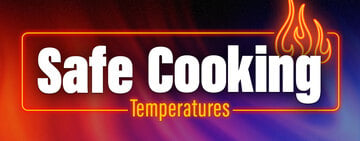
Minimum Internal Cooking Temperatures
To ensure the safety and quality of food, chefs must know the minimum internal cooking temperatures of different dishes. Cooking food to the right temperature enhances its taste and texture and eliminates harmful pathogens that can cause foodborne illnesses. Whether you're a professional chef or a culinary student, learning the recommended cooking temperatures is essential for maintaining food safety standards and avoiding the temperature danger zone . Safe Cooking Temperatures Fortunately, there's no guesswork for determining safe cooking temperatures. Food safety organizations, such as the United States Department of Agriculture (USDA) and the Food and Drug Administration (FDA), set the minimum internal cooking temperatures to ensure cons
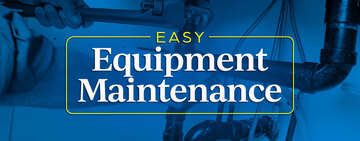
Easy Restaurant Equipment Repair and Maintenance
Most repairs to commercial restaurant equipment should be performed by trained professionals, but there are some simple maintenance tasks you can do on your own that will help to extend the life of your equipment. Avoiding service calls and equipment break downs will save you money and time, allowing you to focus on your daily tasks. Gaskets and Seals Gaskets are used to create a tight seal on the doors of your refrigeration equipment. Over time, they become worn and lose their ability to make an air-tight seal. Many restaurant chains pay for a service to have their gaskets changed out regularly, but if you only have a few pieces of equipment, you can save money by doing the maintenance yourself. Check your gaskets for cracks or tears on a
- Topics 1356
- Industrial 55
- Troubleshooting Guides 21
- Restaurant Management 128
- Bar Management 56
- Catering Tips 36
- Bakery Management 42
- Food Trucks & Concessions 49
- Advertising & Marketing 37
- Eco-Friendly Tips 11
- Facility Layout & Design 42
- Coffee Shop Tips 28
- Installation & Maintenance 51
- Janitorial & Pest Control 30
- Safety & Sanitation 88
- Startup Tips 104
- Menu Design 10
- Kitchen & Cooking Tips 83
- Hospitality Management 24
- Pizza & Sandwich Shop Tips 36
- Smallwares 37
- Food Prep 89
- Tabletop Items 17
- Disposables 22
- Calculators & Tools 6
- Consumables 52
- Warewashing & Laundry 19
- Cooking Equipment 91
- Food Storage & Refrigeration 51
- Beverage Equipment 35
- Office Supplies 6
- Resource Type
- In-Depth Articles272
- Buying Guides298
- How-Tos95
- Product Reviews78


